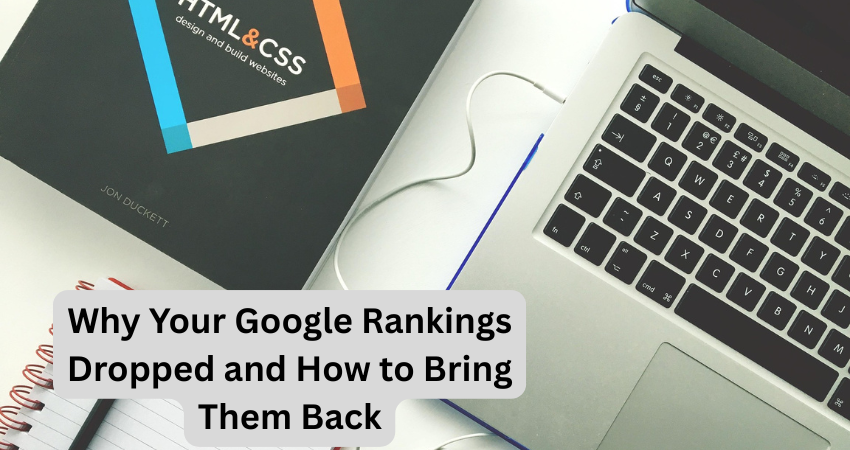
Google ranking plunking, no matter how good a person is at SEO, can happen to anyone for a dozen of different reasons. Some drop events are expected, like ones that come after site changes, while others might just catch you completely off-guard. Very often their ranks are solely responsible for an algorithm modification, some shift in SERP behavior, or sudden competition.
This guide provides a systematic approach to ranking drop recovery. The guide will explore the causes for ranking drops, outline tools for monitoring and analyzing ranking data, and discuss expert tips for recovering ranking position gained and enhancing Google rankings.
Analyze What’s Causing Those Rankings to Drop
Finding out the reasons for low position on Google ranks is the first step, especially when you notice that Google rankings are dropping. Most of the time positions change from one level to another and not every downturn tends to mean disaster, yet continual drop necessitates careful scrutiny. Gather the strong data – make use of important tools like Google Search Console and Google Analytics that are very efficient for tracking where changes occurred and why. Use the Performance report of the GSC for analysis by comparison of the average positions, clicks, impressions, and click-through rates over time to derive which pages have lost visibility and the impact on traffic.
Check for example updates of pages recently done, for instance, technical fixes or otherwise URLs restructured. Many times even a little change has had adverse unintended SEO consequences. If recently you had made changes and rankings began dropping just after that, then it is likely that an issue was created. Furthermore, check out your important pages to ensure they continue to be indexed with the help of the site: search operator or the Page Indexing report of GSC. If valuable pages are missing, this could possibly indicate indexing errors or penalties.
Exclude External Ranking Drop Factors
Further, analyze the effect of external situations that might have impacted the ranking of your site before looking into the internal issues of your site’s SEO. First, look at the GSC’s Manual Actions report for manual penalties. Although rare, significant ranking losses may occur from such penalties imposed on your site due to spam policy violations by Google. Look out for alerts such as unnatural links, thin content, cloaking, or spammy behavior.
Then check on the recent Google algorithm updates. Typically, just within the first quarter of 2024 alone, several core and spam updates rattled the SEO world. If your rankings started dropping during or immediately after one of these updates, it would likely be because of new ways that Google assesses content and authority. Use SE Ranking, Moz, or SEMrush Sensor to observe algorithm volatility and date it with your ranking trends. Finally, external changes in the industry or bad press could also affect the visibility of searches related to a brand.
Check Your Site’s Technical Health for Any Changes
Technical SEO is to be the very base of any visibility that you get for your website. Changes in site speed, mobile usability, structured data errors, or any downtime from the server can lead to impacts on your rankings. You should then start checking the Experience and Core Web Vitals reports on Google Search Console, which will tell you how the users evaluate your site speed and usability on both desktop and mobile.
Audit for indexing errors, like blocked resources in your robots.txt file, no index tags accidentally applied, or any crawl impediments that stop search engines from entering your site. Server log files can be informative to see how Google bot interacts with your pages. Check if there are HTTPS errors, duplicate content, or broken internal links, as they can lower your site authority and provide a poor experience for the user. Any technical downgrades, even by mistake, will cause rankings to drop until resolved.
Audit Your Content
Content remains the king yet only if it fulfills quality and relevance checklists along with search intent check. Steps in the content audit start from pages losing positions as compared to his competitor who is ranking higher than they are at present. Are they more extensive? Are they closer to the search intent match? You can use tools such as Surfer SEO or SE Ranking’s Content Score and compare keyword use, structural usage, and topical depth.
Assess whether: Your contents are outdated, too thin, or less helpful due to an absence of media such as images or videos. As manifested by low dwell time or a high bounce rate from Google Analytics, such content isn’t engaging users. If those few pages show low engagement, try refreshing the page by putting updated statistics, FAQs, or schema markup to improve visibility and interactivity. Finally, search for duplicated content found anywhere on the site, since such duplication may cause cannibalization in ranking or consternation from search engines.
Review Your Website’s Backlinks

Backlinks still have a significant impact on ranking signals. A sudden loss of quality backlinks can downgrade the domain authority and overall search visibility. First, you can check the link profile with the help of tools such as Ahrefs, Moz, or SE Ranking. Check for toxic or broken links, and if applicable, disavow the spammy ones using Google’s Disavow Tool.
Look for backlinks that were lost in accordance with the timing of your ranking drop. These could be due to the removal of the page by the website, removal of your link by the website, or the destruction of that site. Look into whether you’ve lost links to your highest-performing content. Reaching out to reclaim lost backlinks or building new ones can stabilize your SEO authority. Stay away from aggressive or black-hatted link-building practices since they may incur a manual penalty.
Monitor User Engagement and Behavioral Metrics
Increasingly, Google evaluates how users interact with your site. Engagement metrics like bounce rate, session time, and pages per session help search engines know how happy the users are with your content. Use the Pages and Screens report in GA4 to check these metrics for your top pages.
A high bounce could indicate that content is not matching the user’s intent, or else navigating around your page could be hard. A very poor mobile experience may also lead to quick exits. Make sure you optimize your page layout, reduce elements that are too aggressive, and leave your call- to-action clear. Strengthen your internal linking to walk users through the site down to the exit page. Good user experience = higher engagement = support for your SEO activities.
Create a Recovery Roadmap and Monitor Progress
Having dealt with the causes, now the plan of action shall be created. The problems could be then classified as technical, content, or backlink issues. Next, sort fixes as per the level of SEO impact that they might have. For example, before messing with the meta descriptions, one should re-establish high-converting pages for indexing.
Long-term ranking should also be monitored after making the changes to determine which changes actually move the needle. Use SE Ranking or GSC to create baseline metrics and track improvement. Each action taken should be documented so as to correlate them with the performance shift. Most SEO is not going to fix itself overnight. This is a long-term commitment to monitoring and adjusting. Gradually, all these planned efforts will contribute to recovering and improving rankings.
Conclusion
Ranking drops can be irksome, but they go with the territory of SEO. So don’t panic! Instead, strategize. Technical problems, content-related issues, problems with backlinks, or even external factors such as an algorithm update-every drop in ranking has an underlying cause and with it a potential solution.
Get ahead of the problems by using trusted instruments-Google Search Console, Google Analytics 4, and platforms like SE Ranking-and act taking an informed decision early on. Put efforts into indexing, performance trends, content quality profiles, and link health. Even when the culprits are not evident, a systematic approach would almost always expose them.